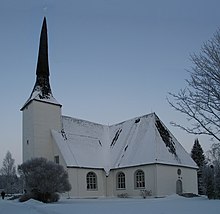Vörå Church
The Church of Vörå is a wooden church in the town Vörå (Vöyri) in the landscape Ostrobothnia in western Finland . It was built from 1626 to 1627 as a buttress church and expanded in 1777 to form a cruciform church . This makes it the oldest wooden church in Finland.
history
At the site of today's Vörå church there was probably a wooden predecessor building as early as the Middle Ages. At the beginning of the 16th century, plans were made to replace the wooden structure with a stone church . As the first construction phase, a stone sacristy was added between 1519 and 1522 . After the Reformation , which was introduced by King Gustav I. Wasa (1523–1560) in the Swedish Empire, the building project had to be stopped, so that only the sacristy of the planned stone church was completed.
In 1626 the old church was demolished and a new wooden church was built in its place. This was completed in 1627 and forms the core of today's church building. In its original form it was a pillar church with a rectangular floor plan and a west tower. The stone sacristy was initially retained and integrated into the new church building. After the church had become too small for the larger number of parishioners, it was decided in 1777 to expand it into a cruciform church. For this, the nave was cut in the middle and the eastern part moved around 12 meters in order to be able to add a northern and southern cross arm. The old sacristy was in the way of the north arm and was therefore torn down. Of the wooden church built between 1626 and 1627, the western part including the church tower has been preserved in its original location, while the eastern part has been moved. They are the oldest components of a wooden church in use in Finland.
Building description and interior design
In its current form, the church of Vörå is a combination of the structural forms of the pillar church, which was predominant in Österbotten in the 17th century, and the cruciform church, which was common in Finnish church architecture in the 18th century. The church has a plan in the form of a Greek cross with equal arms . At the western end there is a slim, 42 meter high church tower . The church is built in block construction and clad on the outside with wooden boards painted white. The church bells are not housed in the church tower, but in a freestanding stack of bells from 1702.
The inventory of the church in Vörå includes an altarpiece , a triumphal cross and several figures of saints that have been preserved from the previous medieval building. The triumphal cross was created in Northern Germany around 1400 , the altar panel in Prussia in the middle of the same century . A sculpture of Saint Olav comes from the same period , probably from Lübeck . These objects were probably brought to Vörå as spoils of war after the Thirty Years' War .
literature
- Markus Hiekkanen: Suomen keskiajan kivikirkot (= Suomalaisen Kirjallisuuden Seuran toimituksia 1117). Suomalaisen Kirjallisuuden Seura, Helsinki 2007, ISBN 978-951-746-861-9 , pp. 526-530.
Web links
Coordinates: 63 ° 9 ′ 4 ″ N , 22 ° 15 ′ 20 ″ E

